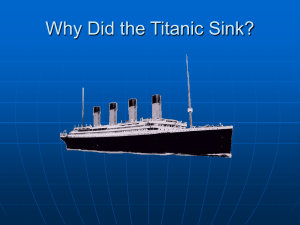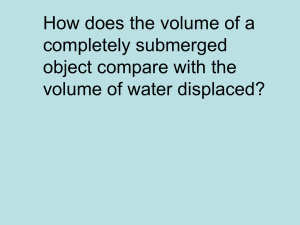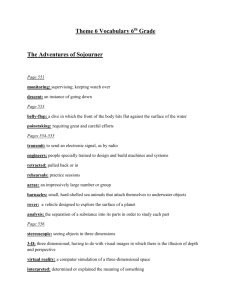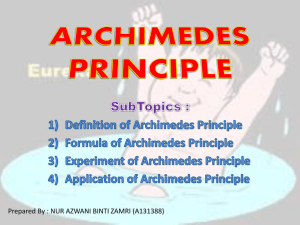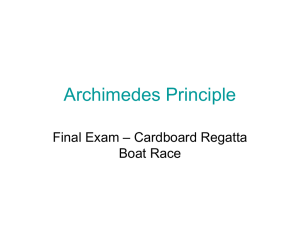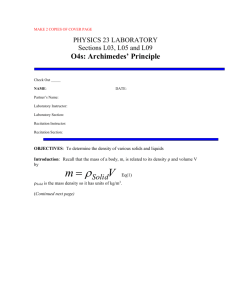Simulation : Archimedes Principle (from Explorelearning
advertisement
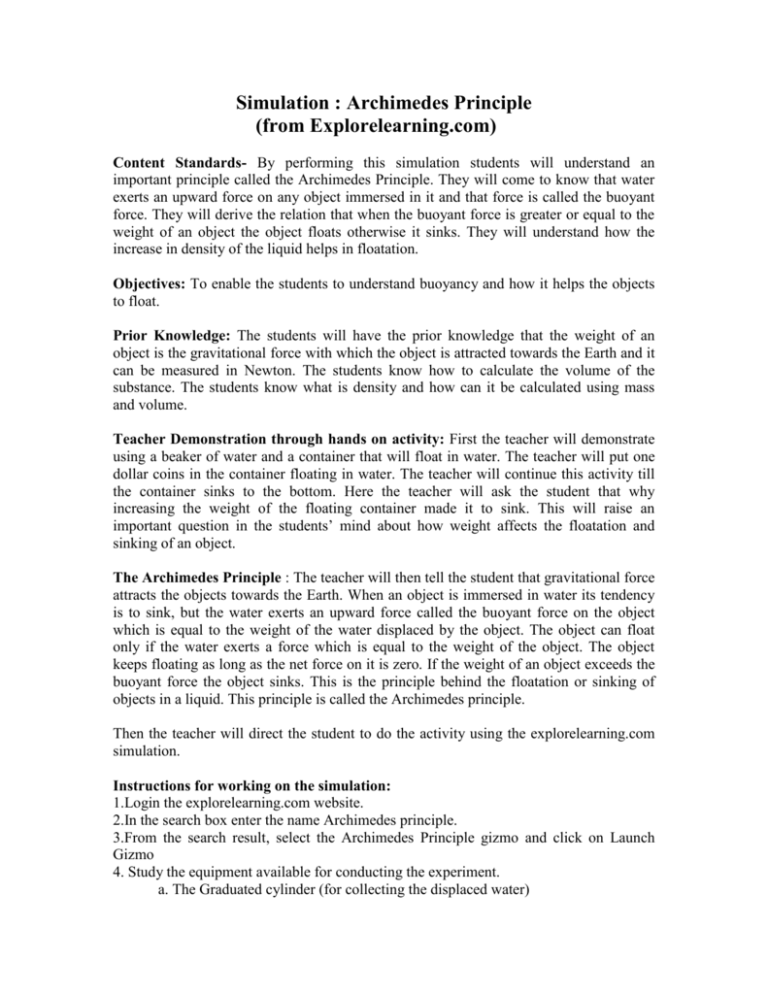
Simulation : Archimedes Principle (from Explorelearning.com) Content Standards- By performing this simulation students will understand an important principle called the Archimedes Principle. They will come to know that water exerts an upward force on any object immersed in it and that force is called the buoyant force. They will derive the relation that when the buoyant force is greater or equal to the weight of an object the object floats otherwise it sinks. They will understand how the increase in density of the liquid helps in floatation. Objectives: To enable the students to understand buoyancy and how it helps the objects to float. Prior Knowledge: The students will have the prior knowledge that the weight of an object is the gravitational force with which the object is attracted towards the Earth and it can be measured in Newton. The students know how to calculate the volume of the substance. The students know what is density and how can it be calculated using mass and volume. Teacher Demonstration through hands on activity: First the teacher will demonstrate using a beaker of water and a container that will float in water. The teacher will put one dollar coins in the container floating in water. The teacher will continue this activity till the container sinks to the bottom. Here the teacher will ask the student that why increasing the weight of the floating container made it to sink. This will raise an important question in the students’ mind about how weight affects the floatation and sinking of an object. The Archimedes Principle : The teacher will then tell the student that gravitational force attracts the objects towards the Earth. When an object is immersed in water its tendency is to sink, but the water exerts an upward force called the buoyant force on the object which is equal to the weight of the water displaced by the object. The object can float only if the water exerts a force which is equal to the weight of the object. The object keeps floating as long as the net force on it is zero. If the weight of an object exceeds the buoyant force the object sinks. This is the principle behind the floatation or sinking of objects in a liquid. This principle is called the Archimedes principle. Then the teacher will direct the student to do the activity using the explorelearning.com simulation. Instructions for working on the simulation: 1.Login the explorelearning.com website. 2.In the search box enter the name Archimedes principle. 3.From the search result, select the Archimedes Principle gizmo and click on Launch Gizmo 4. Study the equipment available for conducting the experiment. a. The Graduated cylinder (for collecting the displaced water) b. Water tank (that represents the ocean) c. A cubic container that is floating in the water tank (represents ship) d. 50g cubes on the right side to increase the weight of ship. 5. The measuring instruments are the :Graduated cylinder, water line (to know how much the ship has immersed in water), show data check box (to see all the measurements). 6. Dimensions of the ship, weight of the ship and the density of the liquid in the water tank can be increased or decreased. 7. Increase the width, length and height of the ship to 10 cm by dragging the right side bar. Keep the density of liquid in water tank to 1g/ml. 8. Start adding the 50g cubes to the ship which has initial weight zero. 9. Each time after adding the 50g cube. Note all your reading in the table below. 10. Keep adding the cubes till the ship sinks. Note : The first two reading have been already taken to guide you. Liquid Density – 1g/ml Width(cm) 10 Length(cm) 10 S.no. Boat Graduated Waterline Mass(g) Cylinder Reading Reading (cm) (ml) 1. 0 0 0 2. 50 50 0.5 Height(cm) 10 Volume of Boat Below Waterline (cubic cm) 0 0.5X10X10= 50 cubic cm Boat Buoyant Total State of Weight Force Force the ship (N) (N) (N) 0 0.49 0 0.49 0 0 floating floatiing Volume of the displaced liquid=Graduated cylinder reading. 2. Repeat the above activity for Width and length= 5 cm and height -10cm. 3. By comparing the findings of all the activities answer the following questions. a. What is the net force on the ship when the ship is floating? b. Which force is more the boat weight or the buoyant force when the ship sinks? c. What is the relationship between the mass of the boat, the volume of the boat that is below the waterline, and the volume of the displaced water each time when the 50g cube is added to the ship? d. Write an expression relating the depth the boat sinks to, the mass of the boat and the base area of the boat. 4. Repeat the above activity for Liquid density to be 2g/ml and all boat dimensions to be 10cm and add two 50g cubes. a. How does increasing the liquid density affect the buoyancy of the boat? b. How far did the boat sink in to the liquid? What was the volume of the displaced liquid? Compare your findings with the results of the simulation with 1g/ml liquid density. In each case of your simulation, what was the mass of the displaced liquid ( Mass =density X volume). How does this relate to the mass of the boat? Q From this activity write a note on the Archimedes principle and its two applications in the daily life.
